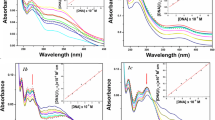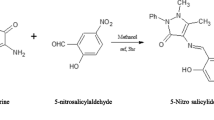Abstract
The Schiff base ligand (L), 3,4,5-Trimethoxy-N-((3-hydroxy-5-(hydroxymethyl)-2-methylpyridin-4-yl)methylene)benzohydrazide (PLTMBH) was prepared by condensation of pyridoxal and 3,4,5-Trimethoxybenzohydrazide. The metal complexes of the ligand with Ni(II), Cu(II) and Zn(II) ions (M) were synthesized. The complexes were characterized by various spectroscopic IR, 1H-NMR, UV, LC–MS and ESR studies and analytical methods as elemental analysis, thermal analysis, molar conductance and magnetic susceptibility measurements. Based on the results, the complexes were assigned distorted octahedral geometry with a metal-to-ligand ratio, 1:2 (ML2). The interaction of the metal complexes with calf thymus (CT) DNA was investigated by electronic absorption and fluorescence emission spectra, viscosity measurements and molecular docking studies. The electronic and fluorescence spectra indicated that the metal complexes can bind to DNA with binding constant (Kb) of 0.819 × 104, 1.014 × 104and 0.427 × 104 M−1 for Ni(II), Cu(II) and Zn(II) complexes, respectively. The viscosity studies suggested groove mode of binding of the complexes with CT DNA. The docking studies of metal complexes with DNA were performed to assess possible mode of interaction, which also supported groove mode of binding for all the complexes. The complexes also showed significant cleavage ability of plasmid pBR322 DNA. The metal complexes showed good antibacterial activity, while the ligand showed moderate activity. The in vitro anticancer assay for the Ni(II) and Cu(II) complexes was performed by standard MTT assay method, against HeLa-Human cervical carcinoma cells, MCF-7-Human breast carcinoma cells and A549-Human lung carcinoma cells. The study indicated appreciable anticancer activity of the complexes.








Similar content being viewed by others
References
Katyal, M.; Dutt, Y.: Analytical applications of hydrazones. Talanta 22, 151–166 (1975)
Mohan, M.; Gupta, M.P.; Chandra, L.; Jha, N.K.: Synthesis, characterization and antitumour properties of some metal(II) complexes of 2-pyridinecarboxaldehyde 2′-pyridylhydrazone and related compounds. Inorg. Chim. Acta. 151, 61–68 (1988)
Singh, R.B.; Jain, P.; Singh, R.P.: Hydrazones as analytical reagents: a review. Talanta 29, 77–84 (1982)
El-Sonabati, A.Z.; Gehad, W.H.M.; Mohamed, G.; Diab, M.A.; Morgan, Sh.M.; Abbas, S.Y.: Synthesis, characterization of Schiff base metal complexes and their biological investigation. Appl. Organomet. Chem. 33(9), e5048 (2019)
Hosny, N.M.; Mahmoud, H.M.; Abdel-Rhman, M.H.: Spectral, optical, and cytotoxicity studies on N-(2-isonicotinoylhydrazine-carbonothioyl) benzamide and its metal complexes. Heteroatom. Chem. (2018). https://doi.org/10.1002/hc.21415
Hosny, N.M.; Mahmoud, H.M.; Abdel-Rhman, M.H.: Synthesis, spectral, modeling, docking and cytotoxicity studies on 2-(2-aminobenzoyl)-N-ethylhydrazine-1-carbothioamide and its divalent metal complexes. Appl. Organomet. Chem. (2020). https://doi.org/10.1002/aoc.5922
Hosny, N.M.; Mahmoud, H.M.; Abdel-Rhman, M.H.: Synthesis, characterization and cytotoxicity of new 2-isonicotinoyl-N-phenylhydrazine-1-carbothioamide and its metal complexes. Appl. Organomet. Chem. (2019). https://doi.org/10.1002/aoc.4998
Wu, Z.; Liu, Q.; Liang, X.; Yang, X.; Wang, N.; Wang, X.; Sun, H.; Lu, Y.; Guo, Z.: Reactivity of platinum-based antitumor drugs towards a Met- and His-rich 20mer peptide corresponding to the N-terminal domain of human copper transporter 1. J. Biol. Inorg. Chem. 14, 1313 (2009)
Richardson, D.R.; Milnes, K.: The potential of iron chelators of the pyridoxal isonicotinoyl hydrazone class as effective antiproliferative agents II: the mechanism of action of ligands derived from salicylaldehyde benzoyl hydrazone and 2-hydroxy-1-naphthylaldehyde benzoyl hydrazone. Blood 89(8), 3025–3038 (1997)
Van Reyk, D.M.; Sarel, S.; Hunt, N.H.: In vitro effects of three iron chelators on mitogen-activated lymphocytes: identification of differences in their mechanisms of action. Int. J. Immunopharmacol 14(5), 925–932 (1992)
Richardson, D.; Ponka, P.; Baker, E.: The effect of the iron(III) chelator, desferrioxamine, on Iron and transferrin uptake by the human malignant melanoma cell. Cancer Res. 54(3), 685–689 (1994)
Sah, P.P.T.: Nicotinyl and isonicotinyl hydrazones of pyridoxal. J. Am. Chem. Soc. 76(1), 300 (1954). https://doi.org/10.1021/ja01630a096
Iheanacho, E.N.; Avramovici-Grisaru, S.: Fe (II)-chelates based on redox-active pyridoxal-betaines as C-centered radicals causing single- and double-strand scissions to DNA. Free Radic. Res. Commun. 11, 307–315 (1991)
Cabantchic, Z.I.; Glickstein, H.; Golenser, J.; Loyevsky, M.; Tsafack, A.: Iron chelators: mode of action as antimalarials. Acta Haematol 95, 70–77 (1996). https://doi.org/10.1159/000203952
Lippert B., Cisplatin: Chemistry and biochemistry of a leading anticancer drug, Wiley Inter-science, (1999).
Ozden, T.; Fatma, G.; Leyla, A.; Betul, A.: Synthesis, characterization and DNA binding studies of platinum(II) complexes with benzimidazole derivative ligands. Bioorg. Chem. 74, 272–283 (2017)
Allardyce, C.S.; Dyson, P.J.: Ruthenium in medicine: current clinical uses and future prospects. Platinum Met. Rev. 45(2), 62–69 (2001)
Ott, I.; Gust, R.: Non platinum metal complexes as anti-cancer drugs. Arch. Pharm. Chem. Life 340, 117–126 (2007)
Nahid, S.; Maryam, M.; Avat, T.; Fatemeh, G.: Synthesis, characterization and in vitro DNA binding studies of a new copper(II) complex containing antioxidant ferulic acid. J. Coord. Chem. 70(15), 2589–2605 (2017). https://doi.org/10.1080/00958972.2017.1363890
Hartinger, C.G.; Dyson, P.: Bioorganometallic chemistry - from teaching paradigms to medicinal applications. Chem. Soc. Rev. 38, 391–401 (2009)
Ferrari, M.B.; Biscegliea, F.; Favva, G.G.; Pelosia, G.; Tarasconi, P.; Albertini, R.; Pinelli, S.: Synthesis, characterization and biological activity of two new polymeric copper(II) complexes with α-ketoglutaric acid thiosemicarbazone. J. Inorg. Biochem. 89, 36–44 (2002)
Arguelles, M.R.; Ferrari, M.B.; Bisce-gli, F.; Pelizzi, C.; Pelosi, G.; Pinelli, S.; Sassi, M.: Synthesis, characterization and biological activity of Ni, Cu and Zn complexes of isatin hydrazones. J. Inorg. Biochem. 98(2), 313–321 (2004)
Ferrari, M.B.; Biscegliea, F.; Buschini, A.; Franzoni, S.; Pelosia, G.; Pinelli, S.; Tarasconi, P.; Tavone, M.: Synthesis, structural characterization and antiproliferative and toxic bio-activities of copper(II) and nickel(II) citronellal N4-ethylmorpholine thiosemicarbazonates. J. Inorg. Biochem. 104, 199–206 (2010)
Sharma, R.; Agarwal, S.K.; Rawat, S.; Nagar, M.: Synthesis, characterization and antibacterial activity of some transition metal cis-3,7-dimethyl-2,6-octadiensemicarbazone complexes. Transit. Met. Chem. 31, 201–206 (2006)
Kavitha, R.; Sireesha, B.; Venkata Ramana Reddy, Ch.: Synthesis, characterisation and antibacterial activity of benzohydrazones derived from 3-hydroxy-5-hydroxymethyl-2-methylpyridine-4-carboxaldehyde. Heterocycl. Lett. 6, 741–747 (2016)
Raman, N.; Pothiraj, K.; Baskaran, T.: DNA interaction, antimicrobial, electrochemical and spectroscopic studies of metal(II) complexes with tridentate heterocyclic Schiff base derived from 2′-methylacetoacetanilide. J. Mol. Struct. 1000(1–3), 135–144 (2011)
Lakowicz, J.R.; Webber, G.: Quenching of fluorescence by oxygen Probe for structural fluctuations in macromolecules. Biochemistry 12(12), 4161–4170 (1973)
Balouiri, M.; Sadiki, M.; Ibnsouda, S.K.: Methods for in vitro evaluating antimicrobial activity: a review. J. Pharm. Anal. 6(2), 71–79 (2016)
Mosmann, T.: Rapid colorimetric assay for cellular growth and survival: application to proliferation and cytotoxicity assays. J. Immunol. Methods 65, 55–63 (1983)
Hetenyi, C.; Spoel, D.V.: Efficient docking of peptides to proteins without prior knowledge of the binding site. Protein Sci. 11(7), 1729–1737 (2002)
Morris, G.M.; Huey, R.; Lindstrom, W.; Sanner, M.F.; Belew, R.K.; Goodsell, D.S.; Olson, A.J.: AutoDock4 and AutoDockTools4: automated docking with selective receptor flexibility. J. Comput. Chem. 30(16), 2785–2791 (2009). https://doi.org/10.1002/jcc.21256
Searle, M.S.; Maynard, A.J.; Williams, H.E.: DNA recognition by the anthracycline antibiotic respinomycin D: NMR structure of the intercalation complex with d(AGACGTCT)2. Org. Biomol. Chem. 1(1), 60–66 (2003)
Leovac, V.M.; Jevtovic, V.S.; Bogdanovic, G.A.: Transition metal complexes with thiosemicarbazide-based ligands. XLIV. Aqua(3-hydroxy-5-hydroxymethyl-2-methylpyridine-4-carboxaldehyde 3-methylisothiosemicarbazone-k3O, N1, N4)nitratocopper(II) nitrate. Acta Cryst. C58, 514–516 (2002). https://doi.org/10.1107/S010827010201586X
Raman, N.; Raja, S.J.; Joseph, J.; Raja, J.D.: Synthesis, spectral characterization and DNA cleavage study of heterocyclic Schiff base metal complexes. J. Chil. Chem. Soc. 52(2), 1138–1141 (2007)
Ferraro, J.R.: Low-frequency vibrations of inorganic and coordination compounds. Plenum, New York (1971)
Nikola, Z.K.; Vukadin, M.L.; Violeta, S.J.; Sanja, G.S.; Tibor, J.S.: Platinum(IV) complex with pyridoxal semicarbazone. Inorg. Chem. Commun. 6, 561–564 (2003)
Lever, A.B.P.: Inorganic electronic spectroscopy, 2nd edn. Elsevier, New York (1984)
Mohanraj, M.; Ayyannan, G.; Raja, G.; Jayabalakrishnan, C.: Evaluation of DNA binding, DNA cleavage, protein binding, radical scavenging and in vitro cytotoxic activities of ruthenium(II) complexes containing 2,4-dihydroxy benzylidene ligands. Mat. Sci. Eng. C-Mater. 69, 1297–1306 (2016)
Jiang, C.W.: Syntheses, characterization and DNA-binding study of chiral complexes ΔΔ- and ΛΛ-[Ru(bpy)2(bdptb)Ru(bpy)2]4+. J. Inorg. Biochem. 98, 497–501 (2004)
Lu, J.; Sun, Q.; Li, J.L.; Gu, W.; Tianab, J.L.; Liuab, X.; Yan, S.P.: Synthesis, characterization, and DNA-binding of two new Cd(II) complexes with 8-[(2-pyridylmethyl)amino]-quinoline. J. Coord. Chem. 66, 3280–3290 (2013)
Mardanya, S.; Karmakar, S.; Mondal, D.; Baitalik, S.: Homo- and heterobimetallic Ruthenium(II) and Osmium(II) complexes based on a Pyrene-Biimidazolate spacer as efficient DNA-binding probes in the near-infrared domain. Inorg. chem. 55, 3475–3489 (2016)
Milutinovic, M.M.; Rilak, A.; Bratsos, I.; Klisuric, O.; Vranes, M.; Gligorijevic, N.; Radulovic, S.; Bugarcic, Z.D.: New 4′-(4-chlorophenyl)-2,2′:6′,2″-terpyridine ruthenium(II) complexes: synthesis, characterization, interaction with DNA/BSA and cytotoxicity studies. J. Inorg. Biochem. 169, 1–12 (2017)
Ju, C.C.; Zhang, A.G.; Yuan, C.L.; Zhao, X.L.; Wang, K.Z.: The interesting DNA-binding properties of three novel dinuclear Ru(II) complexes with varied lengths of flexible bridges. J. Inorg. Biochem. 105, 435–443 (2011)
Zhang, A.G.; Zhang, Y.Z.; Duan, Z.M.; Wang, K.Z.; Wei, H.B.; Bian, Z.Q.; Huang, C.H.: Dual molecular light switches for pH and DNA based on a novel Ru(II) complex. a non-intercalating Ru(II) complex for DNA molecular light switch. Inorg. Chem. 50, 6425–6436 (2011)
Tarui, M.; Doi, M.; Ishida, T.; Inoue, M.; Nakaike, S.; Kitamura, K.: DNA-binding characterization of a novel anti-tumour benzo[a]phenazine derivative NC-182: spectroscopic and viscometric studies. Biochem. J. 304, 271–279 (1994)
Husain, M.A.; Yaseen, Z.; Rehman, S.U.; Sarwar, T.; Tabish, M.: Naproxen intercalates with DNA and causes photocleavage through ROS generation. FEBS. J. 280, 6569–6580 (2013). https://doi.org/10.1111/febs.12558
Li, X.L.; Hu, Y.J.; Wang, H.; Yu, B.Q.; Yue, H.L.: Molecular spectroscopy evidence of Berberine Binding to DNA: comparative binding and thermodynamic profile of intercalation. Biomacromol 13, 873–880 (2012)
Satyanarayana, S.; Dabrowiak, J.C.; Chaires, J.B.: Neither .DELTA.- nor .LAMBDA-tris(phenanthroline)ruthenium(II) binds to DNA by classical intercalation. Biochemistry 31(39), 9319–9324 (1992)
Phadtea, A.A.; Banerjee, S.; Mateb, N.A.; Baneerjee, A.: Spectroscopic and viscometric determination of DNA-binding modes of some bioactive dibenzodioxins and phenazines. Biochem. Biophys. Rep. 18, 100629 (2019)
Tweedy, B.G.: Plant extracts with metal ions as potential antimicrobial agents. Phytopathology 55, 910 (1964)
Akindele, A.J.; Wani, Z.A.; Sharma, S.; Mahajan, G.; Satti, N.K.; Adeyemi, O.O.; Mondhe, D.M.; Saxena, A.K.: In Vitro and In Vivo Anticancer Activity of Root Extracts of Sansevieria liberica Gerome and Labroy (Agavaceae). Evid.-Based Complementary Altern. Med. Article ID 560404 (2015). https://doi.org/10.1155/2015/560404
Acknowledgements
The authors are thankful to Jawaharlal Nehru Technological University Hyderabad, Hyderabad and Osmania University, Hyderabad, India for providing necessary research facilities to carry out this work.
Author information
Authors and Affiliations
Corresponding author
Ethics declarations
Conflict of interest
The authors declare that there are no conflicts of interest.
Supplementary Information
Below is the link to the electronic supplementary material.
Rights and permissions
About this article
Cite this article
Ramdas, K., Reddy, C.V.R. & Sireesha, B. Synthesis, Characterization, DNA Binding, Cleavage, Antibacterial, In vitro Anticancer and Molecular Docking Studies of Ni(II), Cu(II) and Zn(II) Complexes of 3,4,5-Trimethoxy-N-(3-Hydroxy-5-(Hydroxymethyl)-2-Methylpyridin-4-yl)methylene)Benzohydrazide. Arab J Sci Eng 47, 407–418 (2022). https://doi.org/10.1007/s13369-021-05562-2
Received:
Accepted:
Published:
Issue Date:
DOI: https://doi.org/10.1007/s13369-021-05562-2




